Founded in 1861 by Matthew Vassar, Vassar College in Poughkeepsie, N.Y., consistently ranks among the top liberal arts colleges in the U.S. In 1865, the college opened its doors and offered young women a liberal arts education that matched the best men's colleges. For the first time, women were invited to take courses in art history, physical education, geology, astronomy, music, mathematics and chemistry. The college swiftly gained a reputation for intellectual rigor that led to the founding of the first Phi Beta Kappa chapter (the U.S.' oldest academic honor society) at a women's college.
In 1969, after declining an invitation to merge with Yale University, New Haven, Conn., Vassar College became a co-educational college known for setting the standard for higher education. It continues to be renowned for pioneering achievements in education and its long history of curricular innovation, as well as its campus's beauty. More than 1,000 acres of manicured lawns and formal gardens provide Vassar College's 2,400 students and faculty with a picturesque landscape.
Located in the Students' Building, the All Campus Dining Center serves the entire Vassar College community as a central dining facility and provides seating for more than 1,000 people. In 2012, the dining center's slate and copper roof systems, including a gold-leafed copper finial, were restored. Selected by Vassar College for its extensive experience with slate roof systems, Hayden Building Maintenance Corp., West Nyack, N.Y., installed the new roof systems.
"The project required a skilled and knowledgeable roofing contractor who has mastered the art of installing slate, as well as built-in gutters, flashing, flat-seam roofing on the cupola dome and restoration of the dome's gold-leafed copper finial," says Julie Palmer, architectural conservator for Levine & Co. Inc., Ardmore, Pa., the project's roof consultant. "Kevin Lyons, Hayden Building Maintenance's steep-slope division president, is an expert with these and many other steep-slope roofing components."
The cupola
On March 6, 2012, Hayden Building Maintenance began its work on the dining hall. Occupational Safety and Health Administration-compliant scaffolding was erected at the roof level and surrounded the cupola; two stair towers provided access to the rooftop.
The first task was to refurbish the cupola, which is 75 feet above the ground. All the surfaces were lead-abated, and new mahogany trim pieces were added. Hayden Building Maintenance fabricated and installed a new mahogany rail system around the cupola, as well as a new mahogany door with stainless-steel hardware.
The cupola's copper roof system then was removed down to the wooden deck, and all deteriorated wood was replaced. Carlisle WIP® Products' WIP 300 HT self-adhering underlayment was placed on the deck, followed by 20-ounce copper panels tinned and soldered to custom sizes to match the original panels. A 20-ounce copper shelf flashing with an expansion joint and drain tube also was installed. The cupola then was stripped and painted with Benjamin Moore® No. 928; the louver slats were painted with Benjamin Moore No. 673.
The spire then was removed and transported to Hayden Building Maintenance's off-site warehouse where it was stripped and prepped for refurbishing. An etching primer was applied followed by two coats of zinc chromate primer. An oil size then was applied to the spire, and finally, the entire spire was gold-leafed, a process that took 10 days to complete.
After another week of drying, the entire finial was covered with three layers of cotton and bubble wrap to ensure safe transport and installation by crane to the top of the building, where it was attached to the cupola by soldering 20-ounce copper flat-seam panels.
Main roof and portico
Three courses of slate then were removed from the main and portico roof systems down to the wooden decks. Sixteen-inch mottled green and purple Vermont slate, nails and underlayment were removed, and repairs to the deteriorated wooden decks were made. Carlisle WIP Products' WIP 300 HT underlayment then was adhered followed by two-ply 30-pound felt.
The gutter liner was removed along with all deteriorated wood inside the gutter. The gutter was reframed and resloped, and new A-C grade plywood was installed and lined with Carlisle WIP Products' WIP 300 HT self-adhering underlayment. Hayden Building Maintenance then installed a custom-fabricated 32-ounce cold-rolled copper riveted and soldered two-piece gutter system and new 32-ounce leader drop.
Using 10-gauge copper nails, Hayden Building Maintenance fastened the slate in random 1/4-inch and 3/8-inch widths to the decks of the main and portico roofs. At the request of Vassar College, a saddle hip also was installed.
Once the slate installation was complete, an Alpine SnowGuards No. 70 copper wire loop snow guard with eyelet was fastened with 1 3/4-inch stainless-steel nails. Next, an Alpine No. 225 three-pipe adjustable brass snow guard bracket with a brass plate was installed.
The building's north side was the last side to be completed. Stainless-steel base flashing was installed, followed by a framed main exhaust fan using 2- by 4-inch Douglas fir and 3/4-inch A-C grade plywood to accept the new custom-fabricated 12-inch interlocking flat-seam tin panels. The top of the fan was removed to install new flashing at the walls' interiors.
Surrounding soffits and columns were stripped and painted with two coats of Benjamin Moore No. 928 paint.
A gratuitous end
On Sept. 8, 2012, Hayden Building Maintenance completed the project ahead of schedule and received praise from the roof consultant.
"We appreciate Hayden Building Maintenance's craftsmanship and attention to detail," Palmer says. "The project ran smoothly and was completed ahead of schedule."
For its exceptional craftsmanship on Vassar College, Hayden Building Maintenance received a 2014 Gold Circle Award in the Outstanding Workmanship: Steep-slope category.
Chrystine Elle Hanus is Professional Roofing's associate editor and NRCA's director of communications.
Project name: Vassar College's All Campus Dining Center
Project location: Poughkeepsie, N.Y.
Project duration: March 2012-September 2012
Roof system types: Copper; Slate
Roofing contractor: Hayden Building Maintenance Corp., West Nyack, N.Y.
Product manufacturers: Alpine Snow-Guards,™ Morrisville, Vt.; Carlisle WIP® Products, Carlisle, Pa.;
Evergreen Slate Co. Inc., Granville, N.Y.; Tri-State Metals LLC, Elmsford, N.Y.
Gold Circle Awards category: Outstanding Workmanship: Steep-slope



